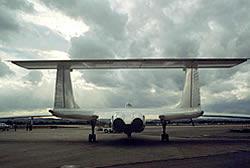Environmental analysis from high altitude flying
When it was deemed necessary by environmental agencies to understand the role of aerosols within the atmosphere, it was quickly found that satellite technology could not provide them with suitable measurements. They would need a high altitude, all weather aircraft with specialized performance, capable of flying for many hours in the stratosphere. The craft would need to be able to carry measuring equipment that could provide in-situ details of particulate materials coupled with microphysical, chemical and transport models in relation to the uncertainties involved in ozone loss. Flying at a maximum ceiling of 21km high, the M-55 Geophysica proved to be a highly useful airplane for measuring microphysical and chemical structures of polar stratospheric clouds. Carrying a payload of 1500kg of equipment the M-55 is capable of both remote sensing and in-situ measurement, because of the array of specialized equipment it can carry. Due to its massive payload, the aircraft is capable of conducting several tests during the course of one flight mission. Such tests include measurement of particles with diameters as small as 23 microns, aerosol and trace gas analysis, condensation nuclei counting to determine their number per volumetric scale, characterization techniques of aerosols and PSC in terms of particle size, shape and refractive index (density), fluorescent measurement of water vapour concentration as well as ultraviolet and infrared spectroscopic measurements of gasses. The M-55, flies now in defence of the environment and furthering our understanding of atmospheric influences leading to and causing ozone depletion.







